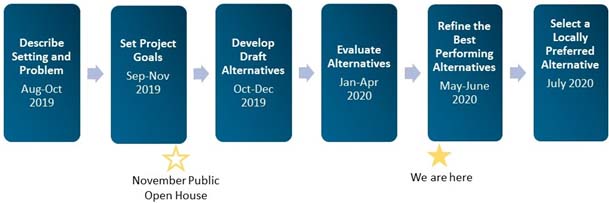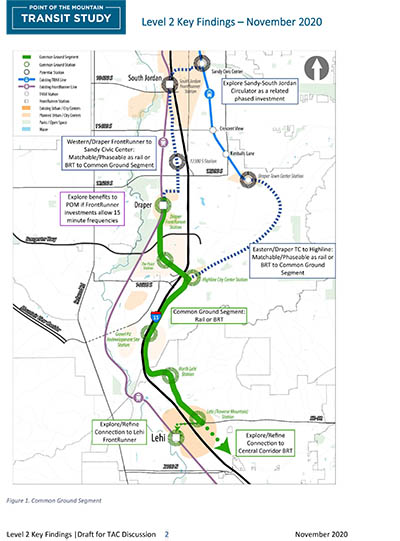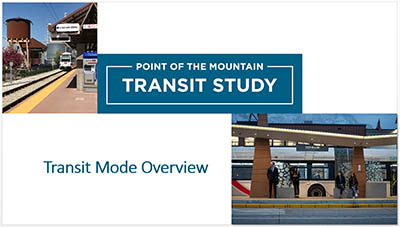Alternative Corridors

E / W Bus Connections

Eastern BRT

Eastern Light Rail

Summary of Alternatives

Western BRT

Western Light Rail

Community Events
Check out open house and other opportunities for public input here.

Open House
Thursday November 14, 2019
4:30 p.m. – 7:00 p.m.
American Preparatory Academy
11938 Lone Peak Pkwy, Draper, UT 84020
Questions? Contact gangerbaue@rideuta.com
A petición, servicios de traducción están disponibles gratis.*
* Request disabled access or translation service at least two days before the meeting.
Public Input
UTA is facilitating a study of potential transit corridors around the Point of the Mountain.
We’d like your input on the study’s goals and your public transit preferences.
How the Analysis Works
The environmental analysis phase of the Point of the Mountain Transit Study will ensure the project safeguards valued natural resources. UTA recognizes the importance of trails, parks, mountain areas, water bodies and clean air, both for maintaining Utah’s quality of life and managing our growth. We previously identified a Preferred Alternative transit corridor (see below). Now, the study is evaluating the corridor’s impact on the environment, including local air, water, and plant and animal life. This analysis is a state and federal requirement of any major project.
The environmental analysis will include the following steps. The step we’re on now is highlighted.
Step 1 --- Step 2--- Step 3 --- etc.
We will invite community input throughout this process (see the link on the right side of the page).
Open House #1
Thursday November 14, 2019
4:30 p.m. – 7:00 p.m.
American Preparatory Academy
11938 Lone Peak Pkwy, Draper, UT 84020
Questions? Contact pomtransit@rideuta.com
A petición, servicios de traducción están disponibles gratis.*
* Request disabled access or translation service at least two days before the meeting.
Preferred Alternative
The “Common Ground Segment” is the Preferred Alternative transit corridor for the juncture of southern Salt Lake County and northern Utah County. Bus Rapid Transit was identified as the best-performing and optimal transit technology for the corridor. The Point of the Mountain Transit Study developed these recommendations through its analysis, including extensive community input, of alternative transit pathways to connect southern Salt Lake County and northern Utah County. The analysis concluded in December 2020 and the final report was issued in early 2021. UTA facilitated the study in partnership with state and local jurisdictions and other key stakeholders. As of early 2021, partner cities, as well as UTA, are ratifying the Common Ground Segment’s selection.

Project Backgound
Alternative Corridors

Project Objectives

Traveling around the Point of the Mountain is a critical problem for Utah. This project, slated to be in the 2050 Regional Transportation Plan, Phase III, proposes a transit connection between the existing prison site to the TRAX Blue Line, the Draper FrontRunner Station and points north and south. The study will evaluate potential alignments for the transit investment that will provide the most viable regional connectivity and mobility, as well as economic development opportunities. A direct transit option is needed between the Silicon Slopes in Utah County, the state-owned existing prison site in Salt Lake County, and the existing transit network.
Project Overview
UTA has been asked by the Point of the Mountain Commission to evaluate transit service options to the Point of the Mountain region. In collaboration with UDOT, WFRC, MAG, Salt Lake County, Utah County and other affected jurisdictions, UTA is working to fulfill this request by conducting a study of potential public transit alternatives around the Point of the Mountain. In consultation with the public, the study will explore and evaluate alternative transit alignments and modes, ultimately leading to the selection of a Locally Preferred Alternative (LPA) corridor. The study will estimate ridership, travel times, travel markets, land use, economics, conceptual engineering, and capital costs for the identified alternatives. Public and stakeholder outreach and input will be a key component of the entire project.
The Point of the Mountain transit study begins from the foundation of previous visioning initiatives, and is one of multiple efforts to resolve the transportation challenges at this critical throughway. Once a Locally Preferred Alternative is identified, an environmental document (ESR or EIS/EA) will be completed. The type of document depends upon funding source (local or federal) and alignment(s) selected.

Transit corridor alternatives identified through prior visioning initiatives
Project Partners

Transit Study Results
The Point of the Mountain Transit Study, which UTA conducted in collaboration with project partners since the fall of 2019, has concluded a detailed alternatives analysis and published the findings for public feedback through a survey (November 23 through December 10, 2020). The final report, which is available at the link below, incorporates public feedback and defines the Locally Preferred Alternative (LPA) which specifies a transit alignment and mode (type of technology) to provide high-capacity transit service from southern Salt Lake County to northern Utah County. The transit alignment, referred to as the “Common Ground Segment,” builds off of previous analysis and public feedback and is a shared transit corridor that was proposed in all previous alternatives.
In the report (see link below), the Common Ground Segment alignment was analyzed for two different mode options: Bus Rapid Transit (BRT) and rail. Both modes provide high-quality transit service, with vehicles operating in dedicated lanes outside of traffic, and both modes include enhanced station area amenities. In the final analysis, BRT was selected as the best-performing transit technology and is the preferred mode for the corridor. For many, BRT is a new concept. This video provides a thorough overview of BRT, including examples of the UVX Bus Rapid Transit system in Utah Valley. In addition to previous outreach efforts, this study has also included a representative survey of households in the Point of the Mountain area.
Final Report and Executive Summary
Please find the final report HERE. The executive summary of the report is HERE.
Locally Preferred Alternative Map
Click to enlarge

Overview of Common Ground Segment Modes
Click to view

Next Steps
The next step in considering transit development around the Point of the Mountain is an environmental review of the LPA. This is slated to occur in 2021, pending availability of funding and other resources.
Contact Us
Questions about the project should be directed to Patti Garver, project manager, at PGarver@rideuta.com
UTA's Role
The role of UTA in the Point of the Mountain transit study is to:
- Facilitate the study process
- Comply with the process’ federal requirements
- Deliver the right service for the approved final alignment
UTA will not:
- Drive economic development
- Promote a specific solution
Project Contact
Patti Garver, Project Manager
pgarver@rideuta.com
Public Input Invited
Initial Alternative Evaluation
We held a public open house in November 2019 to share information about the project and ask for feedback. Click here to review the materials from the November 2019 open house. Given the challenging times we face today, we’d like to utilize this online platform to provide updates on the study and provide the opportunity to hear from you about our work done to date. Since our last public open house, we have:
Developed transit alternatives – this include 5 alternatives, with options on the east and west side of I-15 and that utilize both light rail transit, bus rapid transit, and enhanced bus technologies
Evaluated alternatives – alternatives were evaluated for a variety of factors, such as transit ridership, cost, land use, environmental, and other factors
Maps showing the alternatives, and the results of the alternative evaluation can be found here.

Next Steps and Detailed Evaluation
Based on the findings from the initial evaluation and with input from the public, the following next steps are proposed:
- Perform additional testing to evaluate if potential refinements could improve alternative performance (May-June). This could include combining modes (i.e. light rail transit and bus rapid transit) to create “hybrid” alternatives and exploring alignment modifications along portions of the alternatives.
- Based on public outreach and alternative testing, define the alternatives to be studied in greater detail (June).
- Evaluate the remaining alternatives in greater detail (June-July). This will include additional detailed analysis of cost, ridership, land use and economic development factors, and potential impacts to the natural and built environment (including traffic impacts).
Overview
Thank you for visiting the Point of the Mountain Transit Study website. We invite you to tell us your priorities, comments, questions and concerns related to public transit around the Point of the Mountain. The input form at the bottom of this page will be available through June 3, 2020.
The Point of the Mountain Transit Study is a partnership of governments and agencies exploring transit corridor improvements for the rapidly growing communities of southern Salt Lake County and northern Utah County. The desired outcome of the transit study will be the identification of a Preferred Alternative. The Preferred Alternative will identify the:
- Transit corridor (locations to be served)
- Transit mode (type of transit service)
The study kicked off in the summer of 2019 and has performed the following steps:

Share Your Feedback
We appreciate the comments submitted by the community. As of June 5, 2020, this informal comment period is now closed. If you would like to continue to submit general comments, please use the form on the main Point of the Mountain project page. We will document your input and include it with all other comments in the analysis. Note that additional public comment periods (informal as well as formal) will continue through subsequent stages of the project. We will publicize these opportunities through the media and our participating cities, as we have done thus far.
The Environmental Review
With the planning and alternatives analysis process completed, the Point of the Mountain Transit Study is moving into the initial stages of project development, which will include conceptual engineering and environmental documentation. UTA will again work together with the Utah Department of Transportation, Draper City, Lehi City, South Jordan City, Sandy City, Wasatch Front Regional Council, Mountainland Association of Governments, Salt Lake County, and Utah County to complete this phase of the project.
This phase of the project will include environmental review and documentation of the project consistent with the National Environmental Policy Act (NEPA). It is anticipated that an Environmental Assessment (EA) or potentially a DCE (Documented Categorical Exclusion) is the appropriate environmental document for this project. The environmental process will help to integrate design, transportation, environmental, and public outreach efforts leading to a project ready for approval and possible funding from the Federal Transit Administration.
The environmental review will include evaluation of the following categories:
- Acquisitions and Relocations
- Air Quality
- Biological, Streams, and Wetlands
- Community and Social
- Economic
- Energy
- Environmental Justice
- Floodplains
- Geology, Soils, and Groundwater
- Hazardous Materials
- Historic and Cultural Resources
- Land Use
- Noise and Vibration
- Recreational
- Transportation
- Visual and Aesthetics
- Water Resources
- Utilities
- Construction
- Cumulative and Indirect Impacts
- Mitigation
- Preliminary list of permits
- Public Involvement
We will invite community input throughout this process (see the link on the right side of the page).
Transit Study Results
The Point of the Mountain Transit Study, which UTA has been conducting in collaboration with project partners since the fall of 2019, has concluded a detailed alternatives analysis and published the findings for public feedback through a survey (November 23 through December 10, 2020). Findings of this detailed analysis, with consideration of public feedback, will guide selection of a Locally Preferred Alternative (LPA) which specifies a transit alignment and mode (type of technology) that would provide high-capacity transit service from southern Salt Lake County to northern Utah County. The transit alignment considered, referred to as the “Common Ground Segment,” builds off of previous analysis and public feedback and is a shared transit corridor that was proposed in all previous alternatives.
In these updated findings, the Common Ground Segment alignment has been analyzed for two different mode options: Bus Rapid Transit (BRT) and rail. Both modes are envisioned to provide high-quality transit service, with vehicles operating in dedicated lanes outside of traffic, and both modes include enhanced station area amenities. Rail options, such as TRAX, are prevalent throughout the Salt Lake Valley, but BRT may be an new concept. This video provides a thorough overview of BRT, including examples of the UVX Bus Rapid Transit system in Utah Valley. In addition to previous outreach efforts, this study has also included a representative survey of households in the Point of the Mountain area.
"Common Ground" Corridor Map
Click to enlarge

Overview of Common Ground Segment Modes
Click to view

Next Steps
The next step in considering transit development around the Point of the Mountain is an environmental review of the LPA. This is slated to occur in 2021, pending availability of funding and other resources.
Contact Us
Questions about the project should be directed to Patti Garver, project manager, at PGarver@rideuta.com
UTA's Role
The role of UTA in the Point of the Mountain transit study is to:
- Facilitate the study process
- Comply with the process’ federal requirements
- Deliver the right service for the approved final alignment
UTA will not:
- Drive economic development
- Promote a specific solution
Virtual Tour
Here is a virtual tour of the Common Ground Segment, including the approximate location of future transit stations.
What is BRT?
Bus Rapid Transit is a system that uses special buses that run in dedicated traffic lanes to more efficiently get more people where they need to go. BRT typically includes high-frequency service, traffic signal priority, dedicated ticket vending machines, shelters and benches. The Common Ground Segment BRT will include “gold-standard” high-quality transit service that performs like rail. The system will feature nearly 90% exclusive transit guide way.
UVX is UTA’s first BRT system. Watch a virtual tour of UVX from Orem to Provo.
Learn more about BRT systems here.
